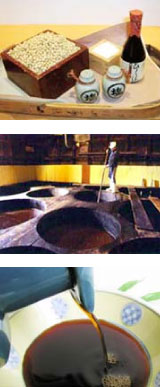Soy Sauce Basics
Soy sauce manufacturing takes long time - at least a year. |
||||

|
Ingredients of soy sauce are simple – only needs soy beans, wheat and salt.Soy sauce is an indispensable seasoning to Japanese cuisines. It contains saltiness, Umami, sourness and sweetness together. Also, just like miso, soy sauce is a fermented seasoning peculiar to Japan. Miso and Soy sauce are mainly made from soy beans and contain "Umami" of glutamine acid. Japanese climate is suitable to produce vegetable fermented foods. Sake, Japanese pickles and natto (fermented soy beans) are also ones of the fermented foods. Temperature, humidity and Moromi stirring process are important factors.Firstly, the equal volume of steamed soybeans and crushed roasted wheat are mixed, then purely cultured seed Koji-mold are added to the mixture. Nextly, Salt, the third and last ingredient, is dissolved into water, which is then mixed with Koji and poured into a large wooden tank. Experts at the factory stir Moromi with fresh air in order to promote fermentation. Flavor, color and aroma of soy sauce are generated and improved slowly during this time. This is called aging. Temperature and humidity are important factors to produce good soy sauce during the process of aging. Our manufacturing method is the one that called Slow Food. We invest a good deal of time and effort to produce good products.When you taste the high quality Moromi, its rich flavor spreads all over your mouth. It is strong and rich aroma that won't easily disappear. After stirring Moromi for about a year and the aging of Moromi is completed, Moromi is squeezed into soy sauce. Only naturally brewed high quality Moromi that aged without haste can create fine aroma and subtle flavor.
|
|||

